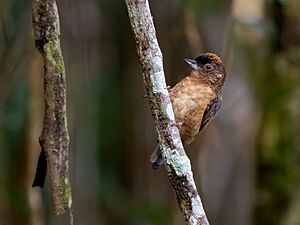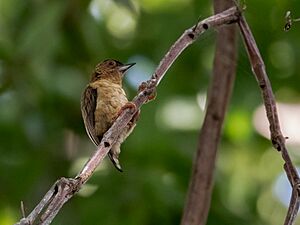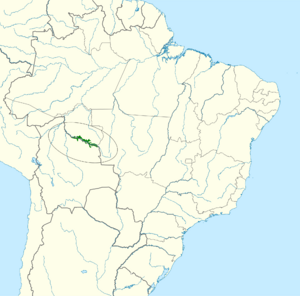Rusty-necked piculet facts for kids
Quick facts for kids Rusty-necked piculet |
|
|---|---|
 |
|
| male | |
 |
|
| female | |
| Conservation status | |
| Scientific classification | |
| Genus: |
Picumnus
|
| Species: |
fuscus
|
 |
|
The rusty-necked piculet (Picumnus fuscus) is a small bird that belongs to the woodpecker family. It's found in a specific area along the border between Brazil and Bolivia. This tiny bird is known for its unique head pattern, especially in males.
Contents
About the Rusty-necked Piculet
The rusty-necked piculet was first described in 1870. For a while, scientists weren't sure if it was a real species. But since 1982, most scientists agree it is its own unique species. It is a monotypic species, which means it is the only bird of its kind and does not have any different types or subspecies.
What Does It Look Like?
The rusty-necked piculet is a small bird, only about 10 centimeters (4 inches) long.
- Males have a special head pattern. The top of their head is dark, almost black. The feathers at the back of their head (called the hindcrown) have bright reddish-orange tips.
- Females look very similar to males, but their crowns are solid black without the reddish-orange tips.
Both male and female piculets have a brownish-yellow face with a reddish tint. They also have a light stripe behind their eye. The sides and back of their neck are a rusty or buff-brown color. Their upper body is brown to brownish-green.
Their flight feathers, which help them fly, are dark brown. Some of these feathers have yellowish-brown edges. Their tail is dark brown. The two feathers closest to their body have mostly white inner parts. The two outer pairs of tail feathers have a thin white bar near the end.
Their chin and throat feathers are brownish-yellow. Sometimes, these feathers have very faint lines. Their underparts (belly and chest) are mostly light brownish-yellow. The sides of their chest and flanks (sides of the body) might have a cinnamon or rusty color. Sometimes, their flanks, chest, and belly have very faint lines.
The bird's eyes are brown, and the ring around their eyes is grayish. Their beak is black with a lighter color at the base. Their legs are grayish-brown.
Where Does It Live?
The rusty-necked piculet lives along the Rio Guaporé. This river is a branch of the Amazon River. It forms the border between the Beni Department in Bolivia and the Mato Grosso state in Brazil.
This bird lives in a special type of forest called várzea forest. This forest gets flooded during certain times of the year.
Movement
As far as we know, the rusty-necked piculet stays in the same area all year round. It does not migrate to different places.
Feeding Habits
Scientists don't know much about what the rusty-necked piculet eats or how it finds its food.
Reproduction
Not much is known about how the rusty-necked piculet breeds or raises its young.
Vocalization
The sounds or calls that the rusty-necked piculet makes have not been described by scientists yet.
Status and Conservation
The IUCN (International Union for Conservation of Nature) keeps track of how many animals are left in the wild. They first thought the rusty-necked piculet was "Near Threatened." But in 2012, they changed its status to "Least Concern." This means they believe it's not in immediate danger of disappearing.
However, this bird lives in a very small area. We don't know how many of them there are, but their numbers are thought to be going down. The main threat to the rusty-necked piculet is more people moving into the area along the Rio Guaporé.


